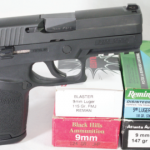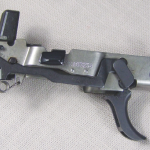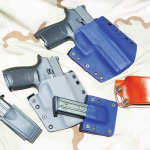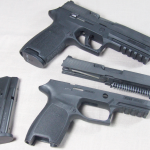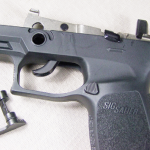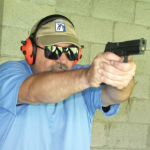By Scott Smith | Contributing Editor
- Compact Sig Sauer P250 with Blaster Ammo from Freedom Munitions, Black Hills 124-grain hollowpoints, Remington’s Frangible 100-grain and Atlanta Ammo’s 147- grain match.
- The serial numbered trigger mechanism of the Sig P250.
- The P250 with its holsters from Dark Star Gear and Galco.
- The P250 full size with the compact X Change below it.
- Removing the fire control unit from the frame.
- Author putting the P250 through its paces on the range.
A few years ago Sig Sauer (18 Industrial Dr., Exeter, Dept TGM, NH 03833; phone: 603-772-2302; online: sigsauer.com) introduced the Sig P250.
This pistol was being considered by the Federal Air Marshals (FAM) to replace their aging P229s. Why on earth would the FAMs consider that move was the thought that ran through my mind? Didn’t Sig already attempt to market a polymer framed pistol: the Sig Pro in 40&W and 9mm? As I recall it was not one of Sig’s best sellers. Will the P250 suffer the same fate of the Sig Pro or will it be a success? What I saw at the Sig Sauer Academy impressed me. The P250 looks good, has a decent double action-only trigger, feels good and fits the hand well. Most importantly, the pistol could be converted from a full sized 9mm to a subcompact .45ACP or it can be a mid-size .357Sig. This might not sound like a big deal, but in the current “gun control crazy world” you can have one pistol that can be configured to meet your needs.
There is only one serial numbered part for all the calibers and sizes. The Caliber X-Change Kit can be ordered directly from Sig Sauer. When ordering the P250 I asked Sig to send me the full sized and compact 9mm.
This would give me pistols the size of a Glock 17-22/19-23, making for a more or less even comparison of arguably the most popular handguns in law enforcement and competitive shooting.
Some of you may question my choice of 9mm versus 40S&W. The answer is simple, I prefer the 9mm and with modern ammunition there is virtually no difference in terminal ballistics; plus I reload 9mm. The 9mm is also an ideal cartridge to compete in USPSA and IDPA because it is comparatively inexpensive and it’s an easy cartridge to reload. There are several local matches each month and I used them as part of the pistol’s test and evaluation; to see how well the pistol shoots and handles. If you have action pistol matches in your area, I suggest you use them to hone your pistol handling skills.
After ensuring the pistol was empty, the P250 was given the once over, and I found the fit and finish to be what I have come to expect from Sig Sauer—flawless. Both grip frames are polymer with molded texturing and Picatinny rails to mount various weapons lights. You will notice there are three external controls, the slide stop which is ambidextrous, the magazine release and the takedown lever. There were no visible machine marks, the parts all fit perfectly and the fire control groups swapped easily from one grip frame to the other; we will discuss this shortly. The double action-only trigger was smooth with trigger tension consistent throughout the stroke, and was just a hair under seven pounds; it did get lighter with use and was breaking at six poundsish after 100 or so rounds.
Once I had worked the trigger on the full size P250 I wanted to see how it would feel in the compact frame. To swap the fire control unit, first drop the magazine, ensure the weapon is safe and clear, lock the slide to the rear, rotate the takedown lever down and remove the slide group. Once this is done the take down lever will rotate out of the frame to the left. At this point, pulling up and forward on the fire control group, push the trigger to the rear and it will pull out of the grip frame. To place in another grip frame, start pushing the rear of the fire controls into the slot in the rear of the frame. Once it is moving in, push the trigger to the rear so that it will fit through the trigger hole and the unit should be in the grip frame.
Now insert the takedown lever, ensure that it is down and the slide group can be attached to the frame; rotate takedown lever up to lock the frame and slide together. Once you do this a couple of times you will find you can swap sizes/calibers in less than a minute.
One thing I noticed when making the size change was the recoil springs. Sig uses a woven recoil spring in the full size pistol but in the compact there is a captured flat spring. In the compact size this captured system is easier to install and remove; kudos to Sig for doing this.
Now that I had satisfied the little boy in me by playing with my transformer pistol, it was time to satisfy the adult and see how well it performed on the range. To test the P250 I gathered ammunition from Atlanta Arms and Ammunition, Black Hills, Freedom Munitions and Remington in various bullet weights and ojive designs. A few reloads were added to the mix to ensure that this pistol would shoot whatever you have at hand.
It was not surprising that the P250 would shoot factory new ammunition; Sigs have a reputation for being reliable. During initial shooting, the full size and compact version of the P250 never flinched with lead or various jacketed reloads. This pistol runs like a Timex watch.
What was surprising about the P250 is the consistently amazing accuracy. Many pistols will show a distinct preference for ammunition, be it bullet weight, design or manufacturer.
My test sample of the P250 in either configuration did not do this.
It simply fired nice tight sub- 3½-inch, tenshot groups at 25 yards. To many, this may not sound great, however, this was shot from a simple yoke rest at the range, not a properly set-up Ransom-type rest.
Many of the groups have five and six shots clustered touching, under two inches. The P250 did this with mixed ammunition in the magazine or with one specific manufacturer and bullet in the magazine. This pistol fired boringly consistent groups. In my humble opinion, this is what I want a duty, competition or self-defense handgun to do. You may not be able to find your pistol’s favorite ammunition; so your sidearm better function with what you have.
To carry my P250 I had holsters from Dark Star Gear (DSG—online: darkstargear.com, info@darkstargear.com) and Galco (2019 West Quail Ave., Dept TGM, Phoenix, AZ 85027; phone: 800-874- 2526; online: usgalco.com). DSG is a one man shop in Pittsburgh, PA, and makes some of the nicest Kydex I have used. DSG’s pancake-style holsters work well for daily carry, range work, and my shooting partner uses one for extra duty assignments. Tom fabricated a holster for both sizes of the P250 and a single magazine carrier. Both fit like a glove. Because of his attention to detail and wanting his customer’s to have exactly what they want, DSG is developing quiet a following and I highly recommend Dark Star Gear.
The other holster I used was a Galco Yaqui Slide. This holster has been around for what seems like forever and works well with many pistols. I like the Yaqui Slide with the P250 because it worked well with the full or compact size; I didn’t have to change holsters at the range. Just because a holster is old school, don’t overlook it for use with new school polymer pistols.
I have been using the Sig Sauer P250 for range work, daily carry and even a couple of USPSA matches.
This is a pistol I cannot speak highly enough about; it is reliable, conceals well, is accurate, and with the ability to change frame size and caliber, you will not find a more versatile pistol. Do not overlook the Sig P250 if you are in the market for a new pistol, you will be sorry that you did.

